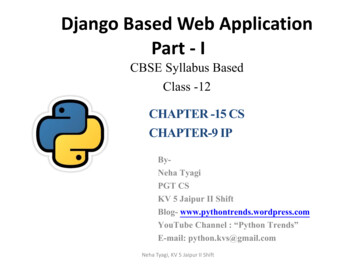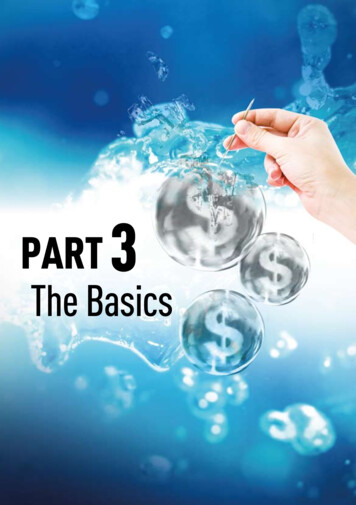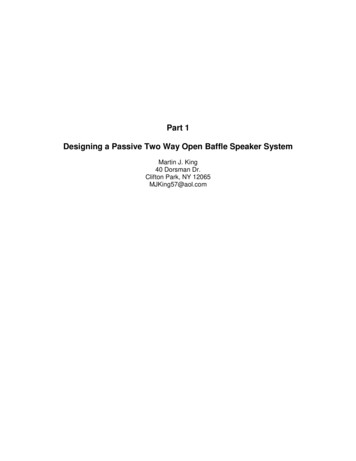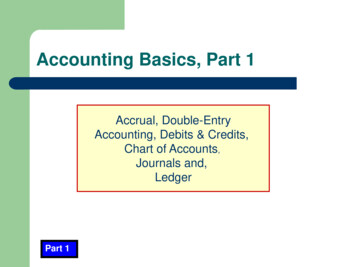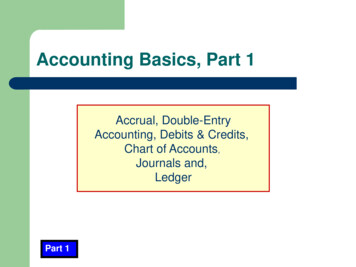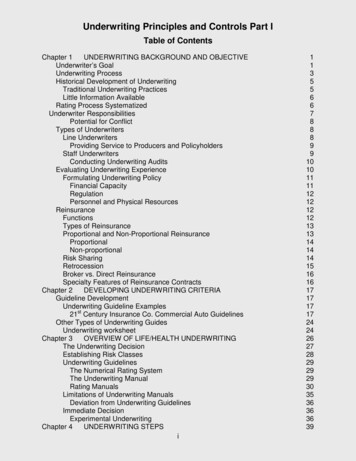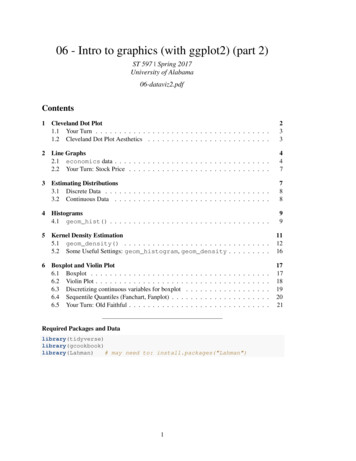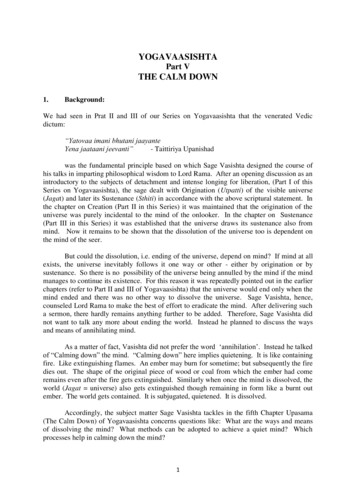
Transcription
YOGAVAASISHTAPart VTHE CALM DOWN1.Background:We had seen in Prat II and III of our Series on Yogavaasishta that the venerated Vedicdictum:“Yatovaa imani bhutani jaayanteYena jaataani jeevanti”- Taittiriya Upanishadwas the fundamental principle based on which Sage Vasishta designed the course ofhis talks in imparting philosophical wisdom to Lord Rama. After an opening discussion as anintroductory to the subjects of detachment and intense longing for liberation, (Part I of thisSeries on Yogavaasishta), the sage dealt with Origination (Utpatti) of the visible universe(Jagat) and later its Sustenance (Sthiti) in accordance with the above scriptural statement. Inthe chapter on Creation (Part II in this Series) it was maintained that the origination of theuniverse was purely incidental to the mind of the onlooker. In the chapter on Sustenance(Part III in this Series) it was established that the universe draws its sustenance also frommind. Now it remains to be shown that the dissolution of the universe too is dependent onthe mind of the seer.But could the dissolution, i.e. ending of the universe, depend on mind? If mind at allexists, the universe inevitably follows it one way or other - either by origination or bysustenance. So there is no possibility of the universe being annulled by the mind if the mindmanages to continue its existence. For this reason it was repeatedly pointed out in the earlierchapters (refer to Part II and III of Yogavaasishta) that the universe would end only when themind ended and there was no other way to dissolve the universe. Sage Vasishta, hence,counseled Lord Rama to make the best of effort to eradicate the mind. After delivering sucha sermon, there hardly remains anything further to be added. Therefore, Sage Vasishta didnot want to talk any more about ending the world. Instead he planned to discuss the waysand means of annihilating mind.As a matter of fact, Vasishta did not prefer the word ‘annihilation’. Instead he talkedof “Calming down” the mind. “Calming down” here implies quietening. It is like containingfire. Like extinguishing flames. An ember may burn for sometime; but subsequently the firedies out. The shape of the original piece of wood or coal from which the ember had comeremains even after the fire gets extinguished. Similarly when once the mind is dissolved, theworld (Jagat universe) also gets extinguished though remaining in form like a burnt outember. The world gets contained. It is subjugated, quietened. It is dissolved.Accordingly, the subject matter Sage Vasishta tackles in the fifth Chapter Upasama(The Calm Down) of Yogavaasishta concerns questions like: What are the ways and meansof dissolving the mind? What methods can be adopted to achieve a quiet mind? Whichprocesses help in calming down the mind?1
Sage Vasishta from this Chapter on turns his attention to a discussion on the appliedaspects – developing methods of practice from the theory so far spoken about. Aspirants ofliberation, therefore, hold this 5000 sloka (verse) strong Chapter in very high esteem. It isconsidered as an invaluable source of techniques for practical observance (saadhana).2.Valmiki’s Narrative Skills:Sage Valmiki, the author of Yogavaasishta, was a great poet and a skillful storyteller. Heuses his own inimitable style of lyrical elegance in depicting the shift in gear adopted by SageVasishta in steering the discussions towards the practical side.Sage Valmiki writes thus:Sage Vasishta’s teaching continued for a period of ten days with two sessions a day –one in the morning and another in the afternoon. On the eleventh day, however, Vasishtaended the day’s d iscourse by noon. He said that they should meet again the next day.Uncharacteristically deviating from the main story at this point, Sage Valmiki, for thefirst time in Yogavaasishta, resorts to a detailed presentation on the daily ritualistic acts ofablutions observed by Sage Vasishta. He also depicts the routine followed by the Royalty ofthe time in general and that of Rama and his brothers in particular. The minute-by-minuteactivities on that specific afternoon were spelt out very meticulously. (This digression ondaily rituals has a significant message for spiritual aspirants, as we shall see shortly.)Though Rama had gone through his daily chores as usual, his mind was totallyoccupied with Sage Vasishta’s teachings. In fact his mind was so infatuated with thesethoughts that its state could be compared to that of a youthful elephant in heat:kariëém kalabho yathä (sarga2- çloka 13)It is quite appropriate to take the word “Kalabha” here to mean an adolescent heelephant. It is well known that he-elephants in heat chase the female elephants withunswerving focus. Rama too was similarly ruminating on every word of Vasishta withsingle-minded attention.As the night progressed, all his brothers fell asleep. But Rama was unable to get evena wink. He sat up on the bed. He recalled each word spoken by Sage Vasishta sequentiallyfrom day one. He reviewed and examined every statement incisively. Not stopping at that,he analyzed the truth behind each of the statements in his own way. Commendable indeedwas the one-pointed attention of the Lad, Rama!ki midaà näma saàsärabhramaëaà ki mime janäù bhütäni ca viciträëiki mäyänti prayänti kim (sarga 2 -çloka 14)“What is this world? What are all these people? What are the elements (Panchabhutas) that constitute the world? Wherefrom do they come? How do they form? Where dothey go to and how?”2
He mused over again and again Sage Vasishta’s teachings recollecting each sectionand each chapter.Soon it was dawn. The Royal bands began playing auspicious tunes of wake up calls.As Rama was already awake, he proceeded straight to complete his morning ablutions after abath. His brothers followed him. All of them went to Sage Vasishta’s hermitage. Theyfound Vasishta in deep meditation. So Rama and his brothers waited for Vasishta toconclude the latter’s meditation.It was full morning by then. Several nobles, princes, saints, and many others alsoreached Vasishta’s abode. Vasishta got up after a while and greeted everybody. Thereafter,he went to King Dasaratha’s (Rama’s father) court by a chariot along with Sage Viswamitrawho was also camping at Vasishta’s hermitage. Sri Rama and his retinue walked in front ofthe chariot paying their respect to Vasishta and welcoming him to the Royal court.All persons took up their respective positions in Dasaratha’s court. King Dasaratha enquiredabout the welfare of Sage Vasishta. He praised Vasishta on the excellent education beingimparted by him to Rama and others. He then asked Rama to get his doubts, if any, cleared.As we already said, there was a good reason for Sage Valmiki to describe elaboratelythe daily routine and rituals as well as the churnings going on in Rama’s mind while penningthe eleventh day discourse. Valmiki is indirectly conveying that whatever may be the state ofspiritual attainment of a person, whatever may be the level of philosophical knowledge, heshould not forsake the daily routine sanctioned and prescribed by Vedas. We can infer thisfrom the description of the schedule followed by Vasishta. Rama’s observance of prescribedablutions, in spite of himself being firmly absorbed in Self-inquiry, indicates to us that allaspirants, irrespective of their state of renunciation and intensity of Self-inquiry, havenecessarily to fulfill their daily obligations.Next comes the question as to why did Vasishta discontinue the lessons on theafternoon of the eleventh day. This intermission was introduced with a purpose. It was toemphasize the fact that it would not suffice to merely audition a course in philosophycontinuously by an aspirant. The aspirant had to digest what was taught, mull it over andthoroughly understand what was taught leaving no scope for even an iota of doubt to linger.Every teacher should adopt this method of providing a break, as was done by Vasishta, sothat the student has time for reflection and a self-review. Teaching should be resumed onlyafter such breaks.This interpretation is not a guess or an assumption on our part. Vasishta implied asmuch. When King Dasaratha (Rama’s father) encouraged Rama to come up with wellthought out questions for clarity on what was so far taught to him, Vasishta did not let Ramaspeak. Instead he posed some questions to Rama.kaccit smarasi väkyärthampürväpara vicäritamkaccit smarasi sarväsäàvibhäga marimardanaväkyärthaçcakhilaù kañcittvayä räma vicäritaù3
hyastansya vicärasyarätrau hådiniveeçitaù (sarga 4 çloka 11)“Rama! Did you recall what was taught by me and mentally revise it? Did you review thenumber of ways I classified the subject matter? Did you examine fully the meaning of mywords? Please appreciate that any thing taught will be effective only if one repeatedly mullsover it in one’s own mind!”Not stopping at that, Vasishta summarized what had been taught thus far and askedRama if the latter could remember everything.The purpose of providing half-day break in his tutoring can be inferred from thefollowing questions posed by Vasishta:Vasishta:hyastanasya vicärasya rätrau hådi niveeçitaù(sarga 4- çloka 21)“Did you review the day’s lessons each night? Do you remember every topic?”Rama’s reply was fittingly appropriate.Rama:apästa nidreeëa mayäväkyärtho hådi cintitaù (sarga 4-çloka 26)“I thought over the issues through out the night without resting even for a moment.”3.What Originates and Grows is merely the Mind :As Rama did not have any clarifications to be sought in what was imparted thus far,he did not raise any questions. So, Vasishta continued with his discourse.Vasishta: “Please listen to me carefully as I shall now teach you the most supreme of alltopics — ways to calm down the mind. Just like pillars bear the weight of a building,Raajasic and Taamasic people carry on their shoulders the unlimited illusion of a world. ButSatvic natured persons like you can leave this burden as easily as a snake sheds its skin. Theonly way to do it is through an understanding of the essence of Truth (tatva vicharana).“Whatever is not existent at the beginning and also at the end, but appears only inbetween cannot be Real. Whatever stays permanently at all times (past, present and future)only can be True. How does a thing that has no existence at the beginning and at the endappear to be born and to exist in-between? The fact of the matter is neither anything is bornnor anything has grown. All of this is entirely a play of the mind!”jäyatee mana eeveehamana eeva vivardhatee samyagdarçana dåñöyä tumana eeva hi mucyate (sarga 5- çloka11)4
“What is born here is mind, what develops is also mind. If you consider properly, what isliberated also is mind!”Rama: “You said so very clearly earlier too. It is for sure that the one who is bewitched bythe illusory world is mind; what ages and dies too is mind. Certainly I could understand that.Revered Teacher! Please show the way to transcend the mind.”Vasishta: “Listen then, Rama. There are seven steps to achieve this. They are:1. Study scriptures from the very beginning.2. Keep company of noble persons (Sajjana sangatya) and draw the benefits of the Fourfold Accomplishments (Sadhana Chatustaya Sampatti).3. Purify the mind or in other words cultivate complete renunciation.4. Take refuge under a learned teacher giving up any egoistic feelings.5. If the teacher recommends worshipping a deity with attributes (saguna), follow hisadvice and pray to that deity observing all the prescribed rituals. Thus obtain theblessings of the deity.6. Proceed then with an enquiry into the Truth of “Self”.7. Only after that an individual will be able to realize the Supreme Self hidden minutelywithin one’s own self like the way a prospector recognizes a particle of gold in (aheap of) muck.”“If one goes along these steps sequentially, it becomes clear that the Supreme Self is differentfrom the embodied worldly living-being. A leaf of lotus may exist in water or water may fallon a lotus leaf; but neither one sticks to the other. Similarly the Supreme Self does not getaffected by either worldliness (samsaratva) or by being an individual self (jivatva). Worldand the Supreme Self are totally irreconcilable. Even then, there is an impression created asif the perfect Self is embodied and is immersed within the affairs of the world. The reasonfor this is mind. I have been saying this many times and to many people.”påthagätmä påthagdeehéjala padmalavoopamauürdhva bähurvi raumyeñana ca kascicchåëoti mee (sarga 5 sloka 26)“I holler from roof tops (lit. shout with hands thrown up in air). But nobody cares.”(This sentence is usually ascribed to Sage Vyasa. It appears here in Yogavaasishta also. Maybe it proves that all great minds speak alike!)Vasishta: “Rama! People think that they experience sorrow and happiness in the world. Inreality for whom is this sorrow or happiness? Is it for the inert body or for the Supreme Selfthat transcends everything? It is not possible for sorrow and happiness to impact the inertbody. There is no question of sorrow or happiness affecting Self which transcends them.Obviously then, nobody has happiness or sorrow!”“Everything in this world is imbued with Supreme Self. Supreme Self is infinite. It isever tranquil. Hold on firmly to this view.”“I talked sometime ago about “Creation and Visualization (Srishti – drishti).” I saidto you that the entire ‘visible world’ (i.e. ‘creation’), was nothing but ‘visualization’.5
Nothing was really created. The visible world (visualization of the creation) is no more thanripples in a pond. Or specks of light that appear to a giddy person.“Rama! Do not worry whether the visible world and Reality (Brahman) are one andthe same or two different things. Answering either way would be wrong because the worldyou see is an apparition. Suppose you see a snake at dusk. You find out later under goodlight that it was actually a rope. The snake is not there any more.
5 “What is born here is mind, what develops is also mind. If you consider properly, what is liberated also is mind!” Rama: “You said so very clearly earlier too.It is for sure that the one who is bewitched by

